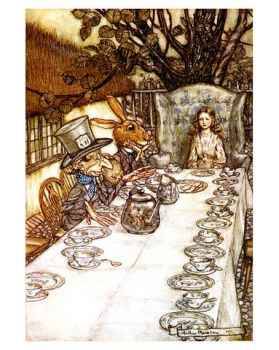On the March Hare Scale: 5 out of 5
I read Pride & Prejudice in high school--so that makes it at least 35 years ago. I remember Elizabeth and Darcy and her intense dislike of him upon their first meeting. And the fact that her mother was desperate to have her daughters married.
What I had forgotten were the details. And how important are the details in this book! This is, much like Harry Potter: a book rich in language, meant to be savored. The dialog zips back and forth. Social barbs are skillfully hidden inside seemingly innocuous statements. Actions and thoughts have consequences--not just for the character involved, but for the family, the village, the county!
P&P is also a love story, or, more accurately, four couple stories. There are the main couple, Darcy and Elizabeth. There is Jane and Bingley. There is Lydia and her amour. And there is Mr. and Mrs. Bennet. Each couple is unique in their love, in how that love developed, in how their love is expressed, and whether Miss Austen thinks their love is lasting.
Darcy finds himself falling in love against his will. Elizabeth, who prides herself on being sensible, discovers that she has been prejudiced--for good and for ill--based on appearances. Jane believes the best of everyone and cannot imagine that others would conspire against her. She is also naturally quiet and reticent, which causes problems. Bingley values the opinions of others over what he feels and thinks. Lydia is impulsive and uncontrolled, spoiled by her parents. Mr. and Mrs. Bennet have been married long and the infatuation which brought them together has not withstood the test of time.
As I read this novel, I began to see why the story is still popular: its lessons still have relevance today. In 1817, when P&P was published, men needed women to help "civilize" them, to remind them of their duties to society and to the family. I find that's still my job today--insisting on "thank you" notes, greeting the older adults at family parties, reminding them to say "good-bye" and "thank you" to the host and hostess when leaving. My daughters may not need a man to provide for them, but I do want them to marry a man who will respect them and cherish them and one whom they will cherish and respect as well.
I also hope that they see that even though Hubs and I drive each other crazy at times, we love each other!
Family loyalty is another theme in P&P. But it is not a "blind" loyalty. There are times when one must have the courage of one's convictions and speak out, even if that means being unconventional. For Elizabeth Bennet, truth is more important than consistency. She is not afraid to speak it, even if it means risking loss or that she must change her mind. Lydia, on the other hand, shows what can happen if all impulses are followed, with no thoughts of consequences.
Now for some editorializing...
The copy I borrowed from the public library had a long, scholarly preface and a Notes on the Text. I decided that I wanted to read the book first, then go back to the references. (This is very unlike me--I'm generally a first-page-to-last-page reader.) The Preface, besides being pendantic, gave away some important plot points. P&P is, first and foremost, a novel. It is an enjoyable read. DD#1's biggest complaint about her High School English classes was that the teachers didn't let them read the novel before pulling it apart and analyzing it. Consequently, she did not enjoy them as much as she might have. That's a valid criticism.
So read P&P without commentary or footnotes. (Although this website has lots of interesting commentary about the background of the book, originally titled First Impressions, and English society of the time. Letters play an important part of the book and this website had interesting information about letter-writing customs of the time.) Enjoy it first.
There seems to be a general consensus that the vocabulary of the Average American, and especially of the Average American Teenager, is shrinking. The fact that teachers pander to the lowest-common-denominator and do not assign works of exceptional authors as reading material is, undoubtedly, a significant reason. I am so tired of the excuse I hear at Back-to-School Night: "But the kids won't read it if they don't think it's relevant!"
Sorry. I don't buy it. You are the teacher. You are the Adult-in-Charge. You decide, out of all the options you have, what your students are going to read. Assign them something challenging! As part of their assignment, have them find the current relevance in a 200-y.o. book about--gasp--male and female relationships! (Elizabeth Bennett is 20; Lydia is 15.) Have them write about it. You hold the power of the Grade!
If all they read is pap written at a 7th Grade level, how will they know they can actually handle something more difficult?
(Please note: this is for the average high school student, reading at or very close to grade level. There are students who, for various reasons, would not be able to read P&P without significant help.)
Okay, I'll step down from my soapbox now...
Monday, January 30, 2006
Pride & Prejudice--The Novel
Posted by
March Hare
at
3:46 PM
![]()
Subscribe to:
Comment Feed (RSS)




|